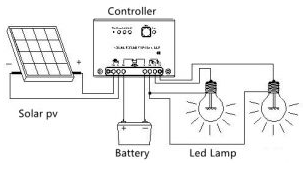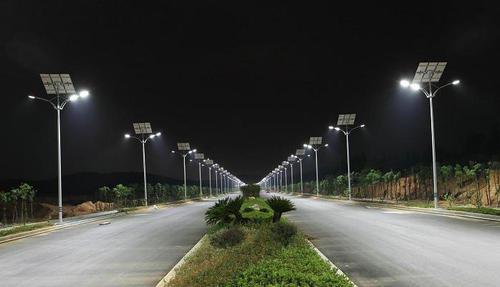How can driving visibility, traffic safety, and pedestrian security be improved whilst reducing the carbon footprint on the planet? This article introduces you to solar street lighting, indicating the importance of it, the main components of the system and the types of systems that can be implemented.
A solar streetlight is an outdoor lighting fixture that uses the light energy given off by the sun to illuminate areas of darkness. It is a practical, simple, and cost-effective device that is used to create driving visibility, improve traffic safety, and enhance pedestrian security.
What are the Main Components of a Solar Street Light?
As seen in figure 1 below, the 4 main components of a solar streetlight are the solar panels, batteries, controllers, and LED lights. The solar panel is used to generate electricity by converting light energy into electrical energy. The conversion efficiency of a solar panel is inversely proportional to the size of it. Solar panels are made up multiple solar cells and the two types of solar cells that are used are mono-crystalline and poly crystalline. Mono-crystalline cells have a more appropriate conversation rate for street lighting hence it is the popular option.

The solar charge controller is used to control the coordinated operation of the solar panel, battery, and the LED accessories. It is device that determines when to turn on or off the lighting and charging. The controller prevents overcharging or undercharging of the battery. The device will transmit the energy generated by the solar panels to the batteries during the day and at night the controller will supply the stored power from the battery to the LED streetlight.
A smart charge controller provides for an excellent energy generation, performance optimization and monitoring of each streetlight by cloud-based software. The use of a built-in communication network with a dedicated software assists for the control and proactive maintenance of the entire street light network.
Controllers are classified as either a simple ON/OFF control, Pulse Width Modulation (PWM) or a Maximum Power Point Tracking (MPPT) device. ON/OFF control is used to provide protection for the battery by preventing overcharging, undercharging or the reversal of current. PWM is used to control the current charging the battery and provides trickle charging. MPPT is implemented in street lighting systems for high efficiency battery charging.
The battery is the energy storage component of the solar streetlight as it stores electricity generated during the day and powers the LED lamp at night. Lead acid batteries or lithium-ion batteries are the two most common types of batteries that are implemented. Lead acid batteries have a life span of 3-5 years and a cycle life of 1500-2500 cycles but have the disadvantage of taking a significant amount of time to charge. Lithium-ion batteries have a greater energy density as well as cycle life and are used in integrated streetlights that require a long cycle life, high energy density and small footprint. These batteries are also advantageous as it has a good thermal stability, high charging efficiency and a short charge time.
Solar streetlights implement LED technology as it delivers a much higher lumen whilst using less energy. Apart from consuming less power, LED lights are more efficient, emit zero ultraviolet light and less prone to failures. Traditional streetlights operate for an average of 5,000 – 8,000 working hours whilst LED fixtures have an average number of 50,000 working hours.
What type of Solar Street Light Systems are there?
Ideally, solar street lighting should be off-grid or, at the very least, hybrid in operation
1. Off-Grid Solar Street Lighting Systems
An off-grid solar street lighting system is one in which each pole has an independent unit that consists of a power source namely Solar Panel or wind turbine, battery, light controller, and a LED light. It is system that can be installed in any area that has sunlight available and does not require electrical wiring or lot of manpower or money.
2. Hybrid Solar Street Lighting Systems
A hybrid solar street lighting system is one in which each pole has a unit that consists of a power source namely grid power, Solar Panel or wind turbine, battery, light controller, and a LED light. It is system that can be installed in any area that has sunlight available and would have a grid connection as a backup source of energy. This is suitable for geographical locations that suffer low sunlight conditions during winter months.
In sum, Solar street lighting allows for grid-independent operation, eliminates the requirement of digging trenches and installing underground wiring as well as assists in the reduction of carbon emissions released into the environment. There are minimal ongoing costs and no energy bills that are associated with solar street lighting. Solar streetlights are advantageous in urban areas as they provide illumination to secondary roads, residential streets, driveways, pathways, parking lots and building perimeters.
Sources:
https://www.srnesolar.com/blog/solar-street-lighting-system-types
https://www.adnsolarstreetlight.com/all-types-of-solar-street-lights-review/


